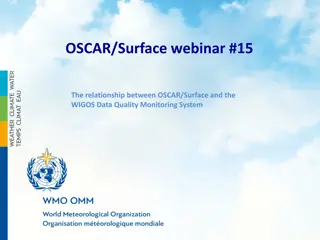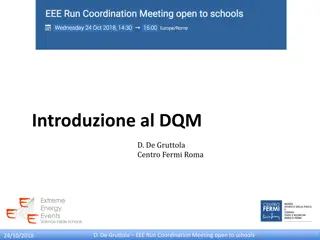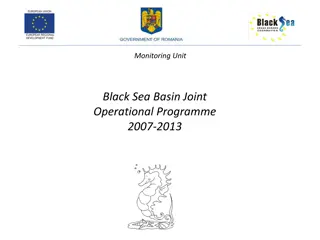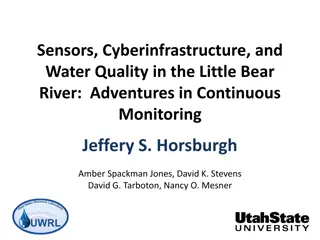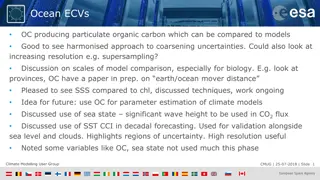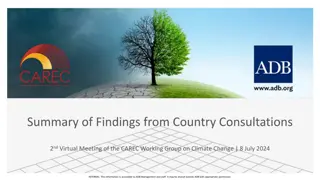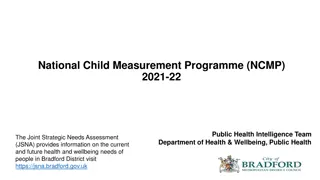Global Climate Monitoring and Data Quality Analysis at NCMP Ayako Takeuchi, JMA ET-NCMP Meeting
Monitoring world climate using CLIMAT and SYNOP data, the GCOS Surface Network (GSN) plays a crucial role in global climate monitoring. The GSN Monitoring Centre, led by DWD and JMA, ensures the availability and quality of CLIMAT reports from over 1,000 monitoring stations globally. With a focus on data accuracy and accessibility, the discussion includes insights on the GSN, RBCN, and data analysis challenges faced by NMHSs. The meeting aims to address resource constraints and optimize role sharing for efficient NCMP calculation.
Download Presentation

Please find below an Image/Link to download the presentation.
The content on the website is provided AS IS for your information and personal use only. It may not be sold, licensed, or shared on other websites without obtaining consent from the author. Download presentation by click this link. If you encounter any issues during the download, it is possible that the publisher has removed the file from their server.
E N D
Presentation Transcript
Questions and suggestions about NCMP Ayako Takeuchi, JMA ET-NCMP meeting (2015.9.15 2015.9.17, @Marrakech)
Self Introduction Monitoring world climate by using CLIMAT and SYNOP data GSN Monitoring Centre and CBS Lead Centre for GCOS Data GSNMC: DWD (Germany) and JMA (Japan) CBSLC: DMN (Morocco), INM (Mozambique), IRIMO (Iran), JMA (Japan), DMC (Chile), NOAA NCDC (USA), BOM (Australia), DWD (Germany) and BAS (UK)
What is GSN? GSN: GCOS Surface Network is minimum configuration for global climate monitoring (about 1,000 CLIMAT stations). GCOS: Global Climate Observing System GSN Monitoring Centre: DWD and JMA monitors availability and quality of CLIMAT reports from GSN stations.
Monitoring results of GSNMC Global: slightly above 80% DWD Graph: Percentage of received CLIMAT reports DWD and JMA received for the last 24 months. Maps: Percentage of received CLIMAT reports from each station DWD and JMA received for the last 12 months. GSNMC website http://www.gsnmc.dwd.de/ JMA
GSN and RBCN GSN: GCOS Surface Network is minimum configuration for global climate monitoring (about 1,000 CLIMAT stations). RBCN: Regional Basic Climatological Network is necessary to provide a good representation of climate on the regional scale, in addition to global scale (about 3,000 CLIMAT stations). Percentage of received CLIMAT reports from RBCN stations is still about 70% (over 80% from GSN stations). RBCN (WMO) GSN (GCOS)
CLIMAT received in JMA (+DWD) JMA receives about 2700 stations CLIMAT data. About 1000/2000/2100 in 2700 CLIMAT reports include data of section 2/3/4. Section 2, 3, 4 contain normal data, number of days with parameters beyond certain thresholds and extreme values and frequency of thunder storms and hails, respectively. There might be difficulties in data gathering statistical calculation encoding CLIMAT reports putting reports into GTS network problems in GTS . Monthly mean temperature (July 2015) from the CLIMAT data received in JMA (+ DWD)
Questions Should each NMHS calculate NCMPs? How about role sharing? NMHSs report necessary data, someone (our team?) calculates NCMPs. There may be problems in resources (computer and/or human), security and so on. Can we modify the definition of NCMP to use existing data for NCMPs? CLIMAT reports include some extreme values as well as monthly mean/total data.
Suggestion 1 For exchange of products, it is better to use a internet tool (web or e-mail), not through the GTS. To put data into GTS, encodings are necessary. For CLIMAT reports, mitigation to TDCF (Table-driven Code Forms) started in 2005, but at present only about 800 stations report BUFR CLIMATs. There are other proposals to NMHSs regarding climatological data. i. Collection of the WWR (World Weather Records) on an annual basis started in 2011. ii. It will be proposed to disseminate another BUFR data to report daily extreme values.
Suggestion 2 It should be better to collaborate Regional Climate Centres (RCCs) that support NMHSs in each region. In JMA, Tokyo Climate Center (TCC) was established in 2002 to support climate services in the Asia-Pacific region and designated as an RCC in 2009. Its major activities are providing climate data and products to NMHSs through the website assisting with capacity building at NMHSs in the region (annual training seminar)
I think that dissemination of basic climatological data like CLIMAT is the most important and makes many communities happier. Thank you.
Contents of CLIMAT report Monthly data Mandatory! Normal data Number of days with parameters beyond certain thresholds Extreme values and frequency of thunder storms and hails Manual on Codes (WMO Publication No. 306) http://www.wmo.int/pages/prog/www/WMOCodes/WMO306_vI1/Publications/ 2014update/Sel4.pdf This code form can be found in 1995 edition.
TCC Annual Training Seminar As part of TCC s capacity-building activity in its role as RCC, TCC holds annual training seminars on the application of its climate monitoring and prediction products. Each seminar deals with a different theme depending on TCC s progress in climate and analysis capabilities, such as the introduction of upgraded climate models. Theme Participants Nov. 2008 Climate Information and Forecasting 13: China, Hong Kong, India, Indonesia, Iran, Korea (2), Lao, Malaysia, Mongolia, Philippines, Thailand, Viet Nam Dec. 2009 Climate Analysis using Reanalysis Data 11: Bangladesh, Indonesia, Laos, Malaysia, Mongolia, Pakistan, Papua New Guinea, Philippines, Sri Lanka, Thailand, Viet Nam Jan. 2011 Application of Seasonal Forecast Gridded Data to Seasonal Forecast Products 19: Bangladesh, Hong Kong, Indonesia, Kazakhstan, Laos, Malaysia, Maldives, Myanmar, Nepal, Pakistan, Philippines (2), Qatar, Singapore, Sri Lanka, Thailand, Uzbekistan, Viet Nam Nov. 2011 One month Forecast Products 13: Bangladesh, Cambodia, Hong Kong, Indonesia, Laos, Malaysia, Mongolia, Myanmar, Pakistan, Philippines, Sri Lanka, Thailand, Viet Nam Nov. 2012 Climate Analysis Information 12: Bangladesh, Hong Kong, Indonesia (2), Laos, Malaysia, Mongolia, Myanmar, Nepal, Philippines, Sri Lanka, Thailand, Viet Nam Nov. 2013 Seasonal Forecast Products 16: Bangladesh, Cambodia, Hong Kong, Indonesia (3), Laos, Malaysia, Mongolia, Myanmar, Nepal, Papua New Guinea, Philippines, Sri Lanka, Thailand, Viet Nam Jan 2015 13: Bangladesh, Cambodia, Indonesia, Hong Kong, Laos, Malaysia, Mongolia, Myanmar, Nepal, Philippines, Sri Lanka, Thailand, Viet Nam Global Warming Projection Information Nov 2015 (scheduled) One Month Forecast 15: Bangladesh, Cambodia, Indonesia, Hong Kong, Laos, Malaysia, Mongolia, Myanmar, Nepal, Pakistan, Philippines, Singapore, Sri Lanka, Thailand, Viet Nam 13 http://ds.data.jma.go.jp/gmd/tcc/tcc/library/index.html










